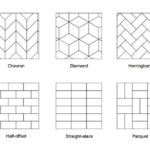What are Arabic Tiles?

Arabic tiles are very famous, but more than only ornaments-they are a testament of a deep cultural heritage spanning centuries. Within their intricate designs, vibrant colors, and unmatched craftsmanship, they have become popular in both traditional and modern spaces. But what makes them so special?
The History of Arabic Tile Art
There is no doubt that these tiles were created during the Islamic Golden Age, that period of extraordinary creativity and innovation. Taking inspiration from nature, mathematics, and spirituality developed into a pattern with richness that elevated their art in symmetry and precision.
Why these Tiles are Famous Across the Globe
These tiles are commended globally for bridging the function with artistry. These are symbols of elegance and timelessness that have made them versatile for use in different architectural and decorative works.
Unique Characteristics of Arabic Tiles


Intricate Geometric Patterns
Tiles are typically characterized by intricate geometric designs drawn directly from the Islamic art principles. The patterns signify unity and infinity in the universe.
Vibrant Color Palette
Fresh bold hues of cobalt blue, emerald green, and golden yellow dominate Arabic tile designs. This creates a visual feast that gives warmth and depth to any space.
Calligraphic Elements
Arabic calligraphy-there in the verses of the Quran or poetic expressions-is another main feature used in Arabic tile art, which adds a spiritual and cultural flavor to the designs.
History of these Tiles

The Emergence of Arabic Tile Art in the Islamic Golden Age
The use of tiles truly flourished in the Islamic architecture of the 8th century, particularly in countries such as Persia, Morocco, and Spain. The art indeed was majorly impacted by the doctrines of Islam, which accepted designs that are abstract and non-figurative.
Influence of Various Cultures on Arabic Tiles
Over time, these tiles borrowed elements of Persian, Byzantine, and even Chinese art to create something uniquely emerging.
Techniques Used in Creating Arabic Tiles



Zellige: The Art of Mosaic
Zellige tiles are a standout in tile art. Made from hand-cut geometric pieces, they are meticulously assembled to create intricate patterns.
Hand-Painted Tile Techniques
Many of these tiles are hand-painted, ensuring that each piece is a unique work of art. This labor-intensive process highlights the artisan’s skill and creativity.
Materials Commonly Used
These tiles are molded from clay then glazed, giving the tiles a glaze. Modern versions have extra amounts of ceramic and porcelain in the tiles for added durability.
Popular Patterns and Designs

Star Pattern and Floral Motifs
The beauty, growth, and oneness of life are reflected through stars, flowers, and arabesques in these tiles.
The Significance of Symmetry
The symmetry used in Arabic tile art is not just aesthetic but also speaks of balance and harmony within the Islamic culture.
Evolution in Designs Over Time
The classical designs are used merely, but contemporary artists have just begun experimenting with minimalist interpretations with the help of tradition and modernity.
Tiles in Modern Architecture

From luxury hotels to public monuments, these tiles cover modern structures to give them the touch of heritage and sophistication.
Home Décor and Interior Design
These tiles can be applied to a feature wall, used for creating a splash at the backdrop of the kitchen, bathroom, or living area.
Renewal globally
Today, people are becoming inclined towards sustainable products and ones that are handcrafted. Thus, the popularity of such tiles is revived in the global markets today.
Benefits of the application of these Tiles

Long Lasting Durable
These tiles are designed to last for centuries. It is very durable and with least wear and tear.
Aesthetically Attractive
Their vivid colors and intricate designs provide them with an immediate focus to any space.
Eco-Friendly Properties
Most of these tiles are comprised of natural products. This makes a green aware homeowner have a wide choice of the tile.
How to Add Arabic Tiles in Your Abode


Wall and Floor Usage
Express your walls and floors beautifully by embracing such tiles. The tiles are therefore suitable for a contemporary theme as well as a traditional theme.
Accent Pieces in Modern Homes
Use Arabic tiles as accents, such as tabletops, stair risers, or even fireplace surrounds, to create understated elegance.
Arabic Tiles Blending with Other Styles
These tiles go well with wood, metal, and even minimalist décor, so the design possibilities are endless.
Tips on Maintaining Arabic Tiles

How to Clean Arabic Tiles
Clean the tiles with a mild detergent and soft cloth. Some chemicals might damage the glaze.
Preserving the Tile’s Finish
They also maintain the glossy look of the tiles, and they prevent moisture penetration.
Conclusion
Arabic tiles go beyond mere décor-they are a gateway to beautiful cultural history. Their designs, bright colors, and timeless appeal make Arabic tiles outshine the elegance of any room. Be it renovating your home or exploring other designs, Arabic tiles offer an exemplary and rightful blend of tradition and modernity.
FAQs
What is interesting about Arabic tiles?
The intricate geometric designs, vibrant colors, and incorporation of calligraphy set Arabic tiles apart.
Do Arabic tiles use outdoors?
Some kinds of Arabic tiles can be glued outside, especially glazed and powerful types
How do I identify the best Arabic tiles for my home?
Think about the theme in your house, tile size, and intricacy of the design so that everything blends in.
Will Arabic tiles be made special?
Yes! Most artisans will deliver custom designs to suit your specific needs.
Where can I find real Arabic tiles?
Order at specialty stores, artisan markets, or online, depending on what suits best for you.



